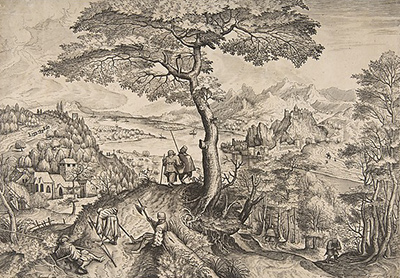Soldiers at rest (or Milites Requiescentes) is a painting of a group of soldiers with long staffs and halberds atop a hill that overlooks the magnificent alpine river valley.
This painting was created by the northern renaissance artist Pieter Bruegel I during the Antwerp period (1554-1562). It is believed to have been painted between 1555 and 1556. Pieter Bruegel I was commonly known as Pieter Bruegel the Elder and he came from an important southern Netherlandish family of artists that was active in the sixteenth and seventeenth century. The original title of the painting was Milites Requiescentes. Milites referred to the trained regular foot soldiers of Rome who not only soldiered but also participated in non-combat roles such as building and labour work. This Latin word eventually became synonymous with the word soldier, hence the change in title.
Soldiers at rest is part of a series of twelve prints that is known as The Large Landscapes. All paintings in this series reflect the deep impression made on Pieter Bruegel as he traversed across the Alps on his return to Italy in the year 1554. His works were carried out mainly in etched lines that appear to be engraved. The paintings were later executed by Joannes and Lucas van Doetecum and they were later published by Hieronymus Cock through his Antwerp shop.
The soldiers at rest painting displays a small group of soldiers carrying long staffs and halberds resting at the top of a hill from where one can clearly view the magnificent alpine river valley. Three of the soldiers are resting in the foreground, two others are at the peak of the hill looking down at the valley and a few other soldiers can be seen strolling up and down routes that lead to various hills that surround the valley. The mountain ranges are clearly depicted in this piece. This painting displays Pieter Bruegel's ability to create strikingly naturalistic landscapes.




